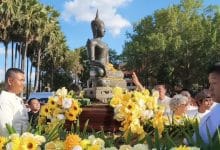Discover Khao Tham Tao: Thailand’s monastery with Buddha’s footprint

Khao Tham Tao Monastery, located in Huai Sai, Khorat, has become a unique tourist attraction in Thailand, holding the awe of visitors with its peculiar massive rock formations. Among these is a giant boulder weighing several hundred tonnes that has braved the elements for centuries, bearing an uncanny resemblance to a colossal turtle.

Beneath this boulder hides a small cave, leading locals to name the site Khao Tham Tao. The monastery was later established and named after this location. However, the wonder doesn’t stop there.
Upon further exploration of the surrounding area, a rock surface with a one-foot deep hole resembling a large human footprint over 2 metres long has been discovered, leading some to believe it could be the footprint of Buddha.

An elder of the Huai Sai village, Kanchanaporn Chengkrathok, recounted that the footprint-like mark has been visible for decades, known to the elder and used as a watering hole for cattle in the past. However, it remained relatively unknown until a group from Uthai Thani province dreamt of a Buddha’s footprint at this location. They followed their dream, discovered the mark, and have since worshipped it, believing it to be Buddha’s footprint, reported Sanook.
Some have asked for blessings and fortune and found their wishes granted, while others have won the national lottery. As a result, every year around March and April, a group travels to perform a ceremony at this site. The monastery and its unique geological features continue to draw the curious and faithful alike, adding a touch of wonder to Thailand’s diverse tourism landscape.
In related news, the mysterious appearance of bumps on a Buddha statue in Nakhon Nayok, Thailand, fascinated locals, drawing crowds seeking lucky lottery numbers. Speculations by an academic suggested humidity-induced rust on metal statues. The phenomenon sparked discussions on traditional versus modern conservation methods.
Latest Thailand News
Follow The Thaiger on Google News:


























